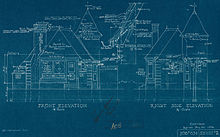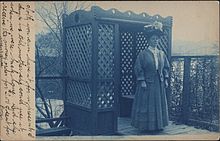
Back Cianotípia Catalan Kyanotypie Czech Cyanotypie German Cianotipia Spanish Tsüanotüüpia Estonian Zianotipia Basque Cyanotype French Cijanotipija Croatian Cianotipia Italian 青写真 Japanese




The cyanotype (from Ancient Greek: κυάνεος, kyáneos 'dark blue' and τύπος, týpos 'mark, impression, type') is a slow-reacting, economical photographic printing formulation sensitive to a limited near ultraviolet and blue light spectrum, the range 300 nm to 400 nm known as UVA radiation.[1] It produces a monochrome, blue coloured print on a range of supports, often used for art, and for reprography in the form of blueprints. For any purpose, the process usually uses two chemicals: ferric ammonium citrate or ferric ammonium oxalate, and potassium ferricyanide, and only water to develop and fix. Announced in 1842, it is still in use.
© MMXXIII Rich X Search. We shall prevail. All rights reserved. Rich X Search